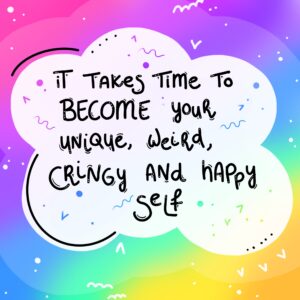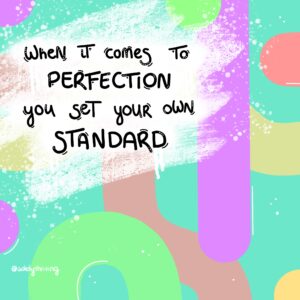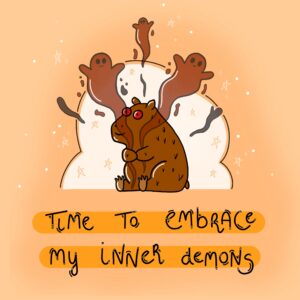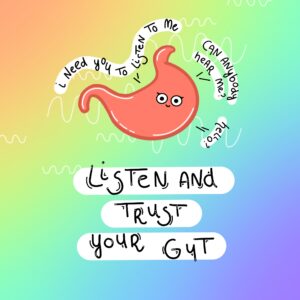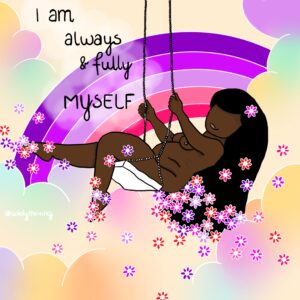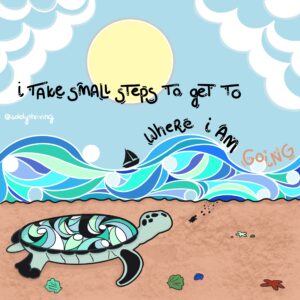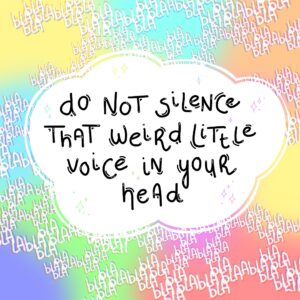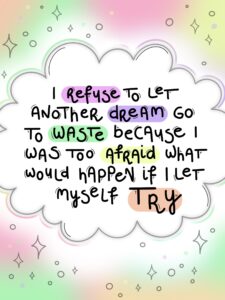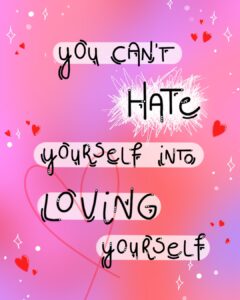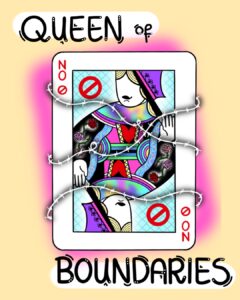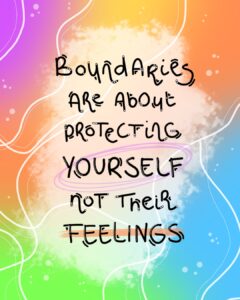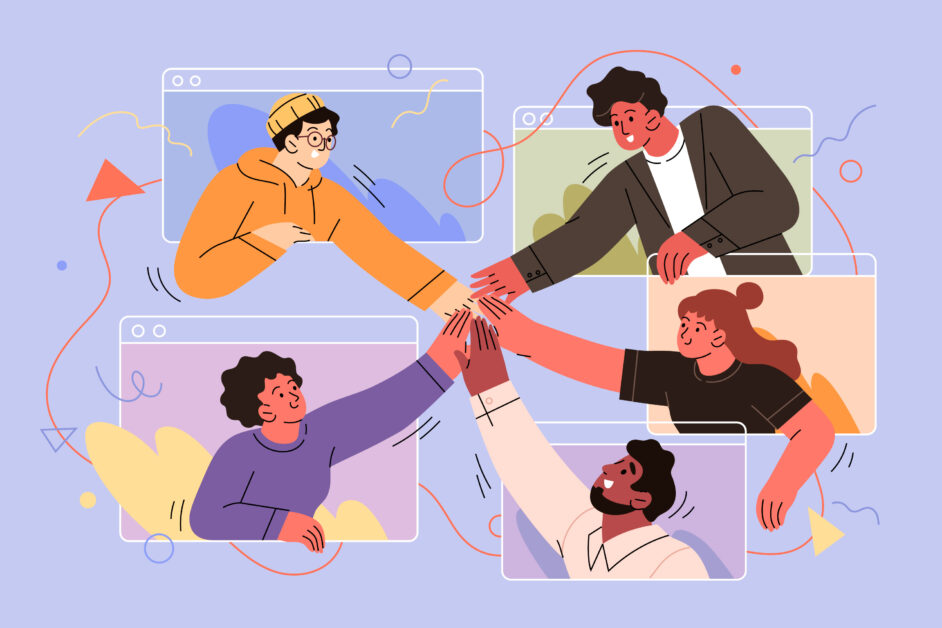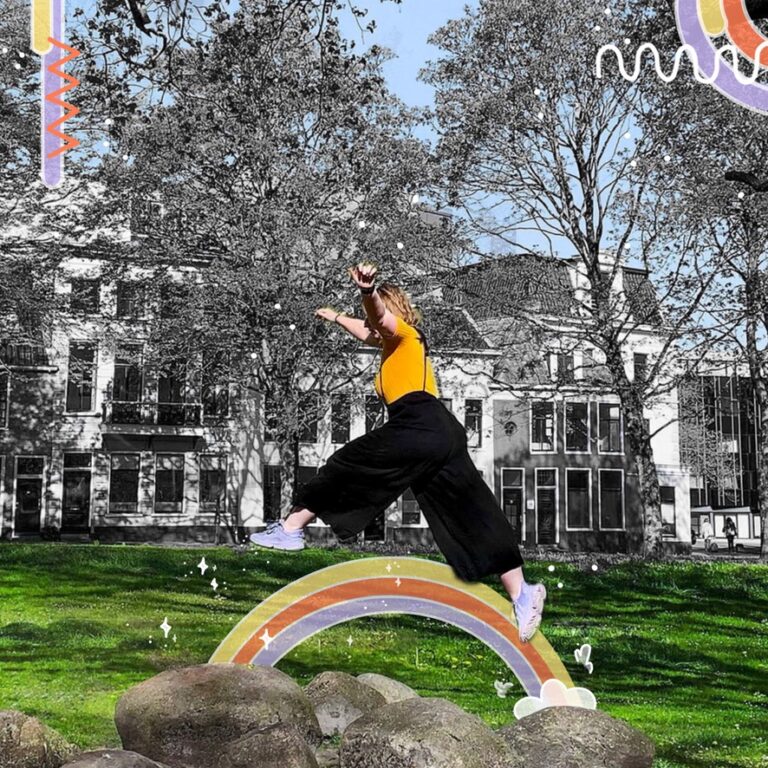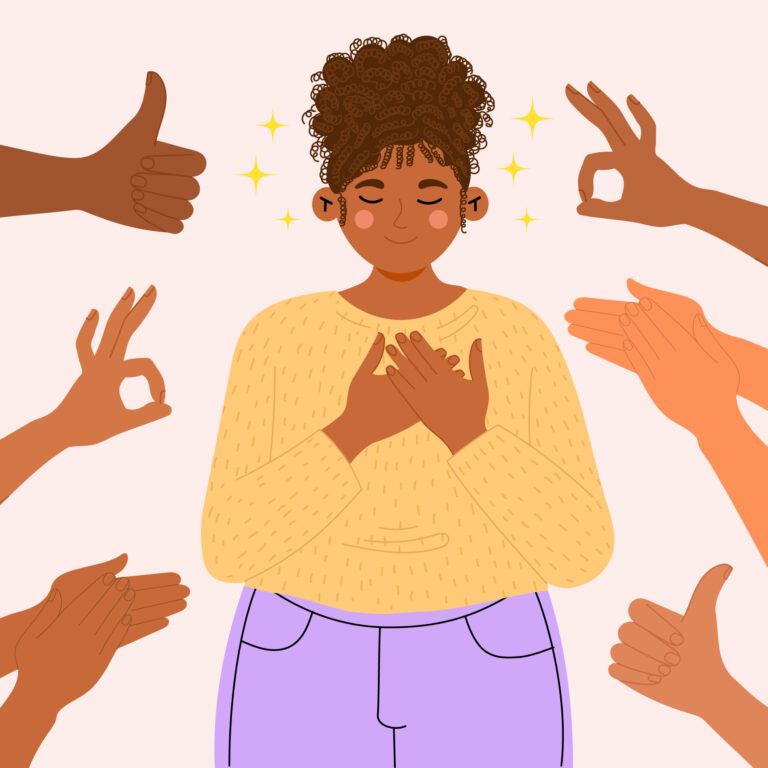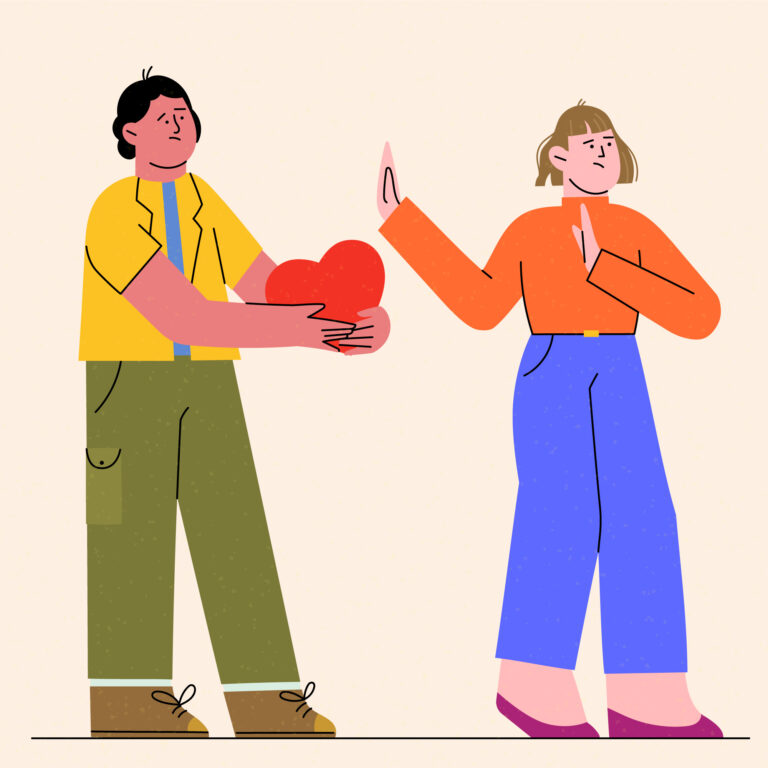How to meditate: finally learn the skill of meditation
If you struggle with meditating, this one might be for you
You probably have heard over and over again how good meditation actually is for you. But no one actually talks about how hard it is to sit down with your thoughts and feelings, close your eyes and – well – just sit there. Because meditation is a skill. And that means you have to get better at it with practice. It isn’t something you just do, it is something you learn. And learning how to meditate is what we will talk about in this blog.
Meditation. My old nemesis.
How can something that is supposed to make you feel more ‘zen’, make you feel so frustrated instead? Or at least that is how I feel about it.
Maybe you feel the same way.
Meditation is one of those things that everybody is talking about and supposedly doing but that you just can’t seem to figure out. Like drinking those green celery juices or doing workouts on a yoga mat in your living room.
It is also one of these things that you assume you should be doing because people keep telling you that the benefits are endless. When all it’s doing right now is making you feel like the kid who can’t keep up in dance class, stumbling along with the music while wondering how everyone just seems to know the steps.
I used to hate meditation and to be completely honest me and meditation are still in the early stages of our friendship, figuring things out, wondering if we could ever be more. Right now I don’t see myself going steady with meditation just yet, but as someone with an anxiety disorder I am well aware of the fact that meditation could be a way for me to clear my head. To calm the endless storm that rages on in the small space behind my forehead.
So I tried it out. Again.
This time with the goal of finally succeeding.
I may have not figured out how to do at-home workouts or drink healthy spinach-colored beverages, but meditation is slowly becoming something that I could manage to do. And now, you might too.
Short summary for quick readers
- Meditation is a skill. That means you won't immediately be able to do it and you need to practice to get better.
- The biggest misconception about 'meditation' is that you need to 'clear your head' and people quit cause they can't do it. Meditation is about being present, not mentally 'blank'.
- Meditation is meant to be awareness of your thoughts and automated mental processes that you normally wouldn't notice. Becoming aware of how quickly your mind wanders can help you stop anxiety in its tracks.
- It can help to use apps or other tools to meditate like Calm, Headspace or the Ten Percent Happier app.
- The first step to meditation is to sit down: find a comfortable position that works for you (for a longer period of time).
- The second step is to set a timer: in the beginning, any time you pick will feel too long. So start out with a number of minutes that feels the least threatening to you. Then build up from that when you notice it getting easier.
- The third step is to close your eyes and focus on your breathing. If you notice that you're thinking about something, go back to your breathing. Repeat this till the timer ends.
- Meditation is a habit. Find a moment that works for you and incorporate it into your daily routine and keep working on it. Even if it feels like nothing is happening. It's a skill.
* Free wallpaper download * Free wallpaper download * Free wallpaper download
* Free wallpaper download * Free wallpaper download * Free wallpaper download
Why meditation is so frustrating
I hate things that I am not instantly good at.
I know I am not alone in this and it is a mindset that holds me back in more ways than just this one, but we underestimate the level of difficulty of something that is just basically breathing. On my worst days, breathing is all I manage to do without much effort.
Why can’t I just sit, breathe in…out…and be fucking relaxed?
Because we think of meditation as something we could just get up and do, we fail to recognize the fact that meditating is a skill. Something we have to get better at. Meditation is learning how to speak Spanish. Or developing writing skills. Maybe you don’t need exactly 10.000 hours of practice to master it, but you do need practice to get better.
The annoying thing about it is that you probably won’t even notice your ‘five minute a day’-efforts until you’ve been forcing yourself to sit down, close your eyes and breathe for months. It is a slow kind of progress. Not the kind of breakthrough you would like to have when you’re trying to learn a new skill. Meditation is working out every day and still feeling just as sore as when you started out.
To keep on setting that timer for five minutes when you don’t feel like you are getting any better – when you feel like you’ll never know what it’s like to be ‘calm’- is HARD.
It is the reason we can’t stick to it for the long run.
The fact that we think meditation is something we should just be able to casually master causes us to feel like a failure every time we criss-cross applesauce into yet another fruitless attempt.
And all of this is because we misunderstand one of the fundamental rules of meditation.
‘You need to clear your head’
Trying to maneuver the toothpaste back into the tube would be a more successful endeavor than clearing your head while you’re constantly bothered by the voice in your head that never learned how to shut up. Sitting down to focus on your breathing while ignoring all the uninvited mental guests that pop up in your brain as soon as you close your eyes is an impossible task.
Because the truth is that those thoughts are already there. Long before you close your eyes.
Our days are filled with thinking; sometimes coherent and sometimes all over the place, but it is always present. So forcing yourself to be completely ‘thought-free’ for as little as five minutes is an unrealistic goal. Five seconds would even be too much.
Still there is this notion about meditation that you are doing it wrong the moment you get distracted. That you should never try again because your mind just won’t stay the peaceful and quiet place that you would like it to be.
You say meditation is not for you because you can not keep from thinking.
I don’t know who came up with the rule to have no thoughts at all, but the inventor of this ridiculous idea has to be completely disconnected from the storms brewing on the inside. Because you can not turn off your thoughts. And anyone claiming they’re able to do so is simply not aware of everything racing through their mind.
The key to meditation is to become aware of the images and words popping up in your head, not to have no thoughts at all. Because of this misconception many people give up their gazillionth attempt at meditating right when they realize their thoughts are not going away. You’re supposed to stop thinking while meditating so then I guess it’s not for you, right?
Wrong.
Meditation is just about being present, not mentally blank. You do not have to be a zombie in order to be able to feel ‘zen’.
All you need to do is sit down and just be.
How to meditate
Is it really that simple?
Well no. If it were, you wouldn’t be reading this blog to finally figure out what the hell you are supposed to do during this glorified breathing exercise.
Meditation will always be hard. The reason why it is hard is because awareness is hard. In a lot of my blogs I talk about awareness being key. Without being aware of the things we do, we can not change our behavior to serve us better. But awareness is really hard. Especially when we have pre-recorded scripts set up that determine how we respond to the different threats we face.
Meditation is the practice that helps you become more aware of all these automated responses we have been collecting during the course of our lives. Awareness so you can intervene and intercept the automatic reaction.
Focusing on your breathing does not just mean that you count your breaths and patiently wait for your timer to end. Just so you can go back to business as usual. Focusing on the flow of your breath helps you create a space for responding instead of reacting. It’s like the Buddhist version of counting to ten.
By practicing being present you will notice that you become more present in your day to day life. You will notice that whenever something triggering happens, you are able to literally keep calm instead of the stampede of mental pictures that used to race through your mind.
And this will eventually help you create a more healthy mental environment.
Imagine that in a situation where you used to play every little detail of the interaction over and over again in your mind, you could do as Elsa says and “let it go”.
Three steps of meditation
I know you. You want to get some clear pointers on how to meditate now.
OK, let’s do just that.
But first of all, I want to give you a little advice. Take it or leave it.
If you have a hard time meditating by yourself, then don’t. There are tons of meditation apps that can help you figure it out. Because meditating by yourself, every day, without having a clue what you’re doing, is just very hard to uphold. So find some help.
(Disclaimer: I am not being paid for recommending these and I won’t get any compensation when you click these links or get a subscription.)
A little helping hand
I have never used apps like Headspace or Calm myself, so I can not recommend them personally, but I have heard from the people around me that it really helped them get into the routine of meditation. So if you need some guidance and a little reminder to keep you going, these are a good option.
An app that I did use is the Ten Percent Happier app that news anchor and meditation-enthusiast Dan Harris co-founded. I like the practical advice that comes with the meditation sessions. Basically, Harris interviews different teachers before every meditation. Perfect if you want to learn more about the practice and the science behind it all.
While you’re figuring out the Ten Percent Happier app, also check out the book Dan Harris wrote. It is a perfect book for people who feel the kind of love-hate relationship with meditation that I have with it. So if you’re feeling skeptical about it all, you might find some comfort in this book. It might make you feel like you’re not the only person who wonders what the hell they’re doing on the bedroom floor breathing in and out for five minutes while thinking about breakfast.
Now, let’s get comfortable and start taking some breaths; we’re going to meditate!
Step 1: Sit down
I mean… Yes. That is the first step.
It might seem a little on the nose but there are different ways to meditate. And the key is to find a position that works for you in a place that works for you. Preferably somewhere quiet and comfortable. Because nothing is more frustrating than being distracted and uncomfortable while trying to relax.
This means that a cross-legged position might not be the right move for you. Sitting like that is fine for thirty seconds but after a minute or so, it’s going to hurt like a mother. So just sitting in a regular sitting position might be the better option. Or maybe you prefer standing up.
Again: there are different ways to meditate. If you want to read more about positions, you can find more information right here.
Just make sure your spine is straight to maintain an upright and more alert position. You can lay down too if you want to but with laying down comes the risk of falling asleep (every. single. time.). So if you know you’re likely to doze off, you might want to sit up for this session.
After picking a position, it is time to start your meditation.
Step 2: Set a timer
The next step is setting a boundary for the torture that is about to commence. I am not going to sugarcoat it: every amount of time you choose is going to feel like an eternity. And it will feel like that for all the sessions to come.
So whether you decide to meditate for one minute in the beginning or five, it won’t really matter. You will feel like a year has gone by and you might even check the mirror afterwards to make sure you have not visibly aged in the time that passed.
I do recommend that you stay consistent. So if you decide your session is going to be five minutes, then all of the sessions after that will have to be five minutes too. So it might be good to set the bar a little lower if you expect that you won’t be able to deal with the excruciating five minutes ahead of you.
Make sure the timer you set fits you and still feels comfortable to you. You’re not here to prove anything. You don’t have to break the record of longest meditation ever. You’re just here to practice meditating and with that, to become more aware of your thoughts and feelings.
So start out easy and build up from that. Eventually you might be able to meditate for thirty minutes. Or maybe you’ll still be doing three minutes. It is all good as long as you meditate with awareness.
Which brings us to the final step.
Step 3: Be aware without punishment
Remember the misconception about meditation that I wrote about earlier? This moment right here, is the key moment of meditation. This is the moment that will determine whether or not you’ll keep meditating.
No pressure though.
The one thing to remember before you start meditating is that it is okay to have thoughts. It is okay for your mind to wander and you have not failed when your mind is not blank the whole time.
So let’s begin.
You’re sitting, you got your timer and you know that you’re going to be okay. Even if you think about dinner or work or that annoying thing that happened in the grocery store.
The only thing you have to do is breathe in and out while being aware of the breaths you take. It might help to think of the words ‘in’ and ‘out’ when you’re breathing. If you notice that you’re knee-deep in thoughts about a project that you still have to finish, just register the distraction and take your mind back to your breaths.
In… and out.
And that’s all there is to it. Just breathe in and out and whenever you notice that you’ve been thinking about other things, you make a little mental note of it and shift your attention back to your breaths. After a few sessions you will notice that you become conscious of the distractions more quickly. That, my friend, is awareness. That is the skill we are trying to improve.
All you are trying to do is get a better grip on your mind so you won’t constantly live in the past or the future, worrying about things that happened or events to come.
And that is what meditation is all about.
Meditation is a habit
One of the important things to keep in mind while you’re trying to get into the meditation practice is that meditating is about something that you are already familiar with: an important part, if not the important part, is turning your moments of zen into daily habits.
And even if meditation is still a puzzle we can not solve, creating habits is something we know how to do. Because of this blog post, creating some form of routine in our lives is something we have become pretty good at.
Which means that we have the skills to turn meditation into a daily practice. Just find a moment that works for you.
I like to meditate right after I get out of bed because the only thing I need to do is get up five minutes earlier than I usually would. So I only lose a little bit of sleep. I tried to meditate at the end of my long and busy day.
Just to unwind.
I set an alarm to remind me of the fact that I should be meditating only to snooze the alarm and go about my usual business. The thing was: I didn’t reap the benefits right away and so it felt like a waste of my precious evening time. The time that I usually spend writing.
The moral of the story: just try different times and find a moment that works for you. Meditating is something you can do any time of day, basically anywhere. If you want to meditate during your work break, then by all means.
And you don’t have to just stick to one meditation a day. If you realize that you would like to meditate more often or if you want to use meditation as a way of dealing with stress then go for it.
I use meditation to fall asleep at night. Whenever I am in bed and my mind is racing, replaying all the events of that day, I breathe in and out. When I focus on my breathing I will eventually get sleepy and doze off.
Meditation can be done anywhere, at all times of the day, multiple times a day. Just make sure you choose one particular moment to make it into a habit. Just to create some kind of routine. It will be easier to keep the practice going that way.
You’re a meditator now
You did it. You’re one of them!
And these simple steps didn’t even involve incense or listening to river noise and birdsong. Although those things can definitely be relaxing.
I know it might not feel like you’re that person now. I know you won’t feel much different after meditating for the first time. There is no huge breakthrough right away, no parade and confetti when the timer ends after your first five minutes.
Just know that even though you can’t feel it, things are happening. You might not notice it right away, maybe not even after five months of consistent meditating, but things are changing. You are learning how to meditate.
One of the first things I noticed was that my stomach (IBS anyone?) settles down faster. No more endless cramps and rumbles. I feel more calm in my gut. Which already is a great effect of meditation.
If you don’t notice anything right away please hang in there. Keep going. You will get there eventually.
Remember: it’s a skill. We will get better at it.
Together.




